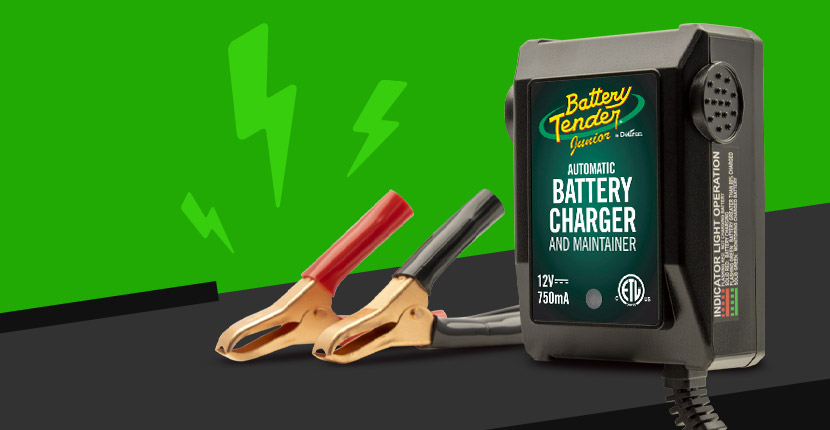When Should You Use a Battery Maintainer?
- by Bryan Veldboom - updated on 10/5/2021

All vehicles rely on batteries in order to start their engines. That's as true of cars as it is boats and riding lawn mowers. When dealing with a battery, it's crucial that you maintain its charge in order to get the longest life possible. A battery maintainer is a fantastic way to do that, especially for seasonal vehicles that sit idle for long periods of time. Keep reading for valuable information on how battery maintainers work, along with a list of suggested maintainers available from Batteries Plus.
What are the Different Types of Battery Chargers?
There are three basic categories of battery chargers: standard chargers, trickle chargers and battery maintainers. Standard chargers work by supplying a constant source of DC (direct current) electricity to a battery. Since standard chargers need to be shut off manually, you have to pay greater attention when using them so that you don't accidentally overcharge your battery.
Trickle chargers are designed for applications that have longer periods of inactivity. They work by supplying your battery with a much smaller amount of electricity over a longer period time. This smaller amount of current means that they require less maintenance than standard chargers. So, can a trickle charger ruin a battery? Yes, while the current they supply is much smaller than a standard charger, a trickle charger can still overcharge your battery if kept on for too long.
A battery maintainer is a kind of "smart" charger that will only supply current when your battery's voltage drops below its ideal level. When the ideal charge is reached, the battery maintainer will shut off and remain that way until the voltage drops again.
Is It Okay to Leave a Battery Maintainer On All the Time?
Unlike standard and trickle chargers, a battery maintainer can be attached to a battery indefinitely without any fear of overcharging. This makes them perfect for seasonal vehicles that will remain idle for longer periods of time. They're also great for maintaining batteries during cold weather, which can drain your battery's power. Using a battery maintainer will help offset this draining effect and protect your battery's charge.
What is the Difference Between a Battery Tender® and a Battery Maintainer?
When shopping for battery maintainers you may see them referred to as "Battery Tenders," which can be slightly confusing. Battery Tender® is simply a brand name that people often use interchangeably with the term battery maintainer. The Battery Tender® brand does manufacture a number of battery maintainers, but they are not the only company that does so. When referring to smart chargers, "battery maintainer" is the more accurate term. Batteries Plus carries a number of Battery Tender® chargers. Here are some of the most popular models:
Battery Tender Jr. 12V 0.75 Amp Charger
- Compatible with all lead-acid, flooded, AGM and gel cell batteries
- Ideal for motorcycles, dirt bikes, ATVs, UTVs, lawn mowers & more
Battery Tender Weatherproof 12V 0.8 Amp Charger
- Compatible with all lead-acid, flooded, AGM and gel cell batteries
- Shock, vibration & water-resistant
- Ideal for cars, trucks, ATVs, personal watercraft, motorcycles, boats & other recreational vehicles exposed to the elements
Battery Tender Plus 12V 1.25 Amp Charger
- Compatible with all lead-acid, flooded, AGM and gel cell batteries
- Ideal for larger vehicles, such as cars, trucks, boats, motorcycles, dirt bikes, ATVs, UTVs, personal watercraft, lawn mowers & more
How Do I Find the Right Battery Maintainer for My Needs?
The first thing you need to do is make sure that the charger you select is compatible with your battery's chemistry. That means if your boat has an AGM battery, you need to find a charger that works with AGM batteries. Using a battery with an incompatible charger can damage your battery.
The other two things to pay attention to are your battery's voltage and amperage. Voltage is pretty easy to understand. The voltage of the charger must match the output voltage of the battery. So, if you have a 12V battery, then you need a 12V charger.
Amperage is slightly more complex. For this, you need to know the amp-hour (Ah) rating of your battery, which can usually be found on the battery's label or manufacturer's website. In order to charge your battery properly, your charger should be a minimum of 10% of the battery's Ah rating. That means that a 100Ah battery requires a 10 amp charger. Keep in mind that you can use a charger with a higher number of amps. A higher amp charger will charge your battery faster, but will probably end up costing you more.
Find Your Battery Maintainer at Batteries Plus
Batteries Plus makes it easy to find battery maintainers for an enormous range of vehicles, including cars, trucks, boats, golf carts, as well as powersport applications like motorcycles, ATVs, UTVs, snowmobiles, personal watercraft and more. Just visit our battery chargers page and select your vehicle of choice. Or, shop in person at your nearest Batteries Plus location. If you plan on storing a vehicle for the weekend, you can get additional maintenance tips in our blog article entitled, "How to Maintain Seasonal Vehicles During the Winter Months."